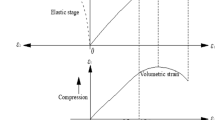Abstract
The mechanical properties are essentially different when rock material is subjected to loading or unloading conditions. In this study, loading and unloading tests with various confining pressures are conducted to investigate the mechanical properties of marble material samples taken from the deep diversion tunnels of Jinping II Hydropower Station. The stress-strain relationship, failure characteristics and strength criterion are compared and analyzed based on the experiment results. The results show: in the loading and unloading test, peak strength, lateral strain, axial strain and plastic deformation increase significantly as the confining pressure increases. Lateral strain increased significantly and obvious lateral dilatancy can be observed to the change of confining pressure; The fracture mode is mainly the single shear fracture for the triaxial compression test and post-peak test, angle between the failure surface and the ends of the rock material becomes smaller as the confining pressure increases. Hoek-Brown strength criterion reflects the strength characteristics of marble material under two different unloading conditions, and has some supplementary effects to the rock material of mechanical field.
Similar content being viewed by others
References
JAEGER J C. Brittle Fracture of Rocks-Proceedings of the Eighth Symposium on Rock Mechanics[M]. Baltimore: Port City Press, 1967
LI Xin-ping, XIAO Tao-li, WANG Bin, et al. Experimental Study of Jinping Marble under Loading and Unloading Stress Paths[J]. Chinese Journal of Rock Mechanics and Engineering, 2012, 31(5): 882–889
CROUCH S L. A Note on Post-Failure Stress-Strain Path Dependence in Norite[J]. International Journal of Rock Mechanics and Mining Sciences and Geomechanics Abstracts, 1972,9(2):197–204
Ghaboussi J, Sidarta D E. New Method of Material Modeling Using Neural Networks[C]. In: Pietruszczak.Pande ed.Proc. of 6th Int.. Symp. on Numerical Models in Geomechanics, 1997
XIAO Tao-li, LI Xin-ping, JIA Shan-po. Triaxial Test Research and Mechanical Analysis Based on Structure Surface Effect of the Deep Rock Mass with Single Tissure[J]. Chinese Journal of Rock Mechanics and Engineering, 2012, 31(8):1 666–1 673
SHEN Mingrong, SHI Zhenming, ZHANG Lei. Deformation Properties of Samples under Different Loading Paths[J]. Chinese Journal of Rock Mechanics and Engineering, 2003, 22(8): 1 234–1 238
GAO Chun-yu, Xu Jin, He Peng, et al. Study on Mechanical Properties of Marble under Loading and Unloading Conditions[J].Chinese Journal of Rock Mechanics and Engineering, 2005, 24(3): 456–460
Sidarta D E, Ghaboussi J. Constitutive Modeling of Geomaterials from Non-Uniform Material Tests[J].Computer and Geotechnics, 1998, 22(1):53–71
WONG T, SZETO H, ZHANG J. Effect of Loading Path and Porosity on the Failure Mode of Porous Rocks[J]. Applied Mechanics Reviews, 1992, 45(8): 281–293
HA Qiuling. Rock Mass Mechanics under Unloading and Loading Conditions[J]. Chinese Journal of Geotechnical Engineering, 1998, 20(1):114–115
LI Jianlin. Theory and Application of Rock Mass Mechanics under Unloading Conditions[M]. Beijing: China Architecture and Building Press, 1999
XU Dongjun, Geng Naiguang. The Various Stress Paths Causing Deformation and Failure in Rocks[J]. Chinese Journal of Geotechnical Mechanics, 1986, 7(2): 17–25
YOU Mingqing, Hua Anzeng. Effect of Stress Path on Strength and Deformation of Specimen[J]. Chinese Journal of Geotechnical Engineering, 1998, 20(5): 101–104
GAO Jishun. Rock Classification of Diversion Tunnel Study of Jinping II Hydropower Station in Yalong River[M]. Chengdu: Chengdu University of Technology, 2009
WU G, Zhang L. Studying Unloading Failure Characteristics of a Rock Mass Using Disturbed State Concept[J]. International Journal of Rock Mechanics and Mining Sciences, 2004, 41(Supp.1):181–187
WITTKE W. Rock Mechanics: Theory and Applications with Case Histories[M]. Berlin: Springer Verlag, 1990
Hoek E, Brown E T. Practical Estimates of Rock Masses Strength[J]. Int. J. Rock Mech. Min. Sci. & Geomech. Abrstr., 1997, 34(8): 1 165–1 186
HOEK E, BROWN E T. Empirical Strength Criterion for Rock Masses [J]. Journal of Geotechnical and Geoenvironmental Engineering, 1980, 106 (GT9): 1 013–1 035
Zienkiewicz O C, Pande G N. Some Useful Forms of Isotropic Yield Surfaces for Soil and Rock Mechanics[M]. In: Gudehus Ged. Finite Elements in Geomechanics. London: John Wiley&Sons Ltd, 1977
Author information
Authors and Affiliations
Corresponding author
Additional information
Supported by National Natural Science Foundation of China (No.50974100), WHUT(NO.125106002)
Rights and permissions
About this article
Cite this article
Li, X., Zhao, H., Wang, B. et al. Mechanical properties of deep-buried marble material under loading and unloading tests. J. Wuhan Univ. Technol.-Mat. Sci. Edit. 28, 514–520 (2013). https://doi.org/10.1007/s11595-013-0723-4
Received:
Accepted:
Published:
Issue Date:
DOI: https://doi.org/10.1007/s11595-013-0723-4




